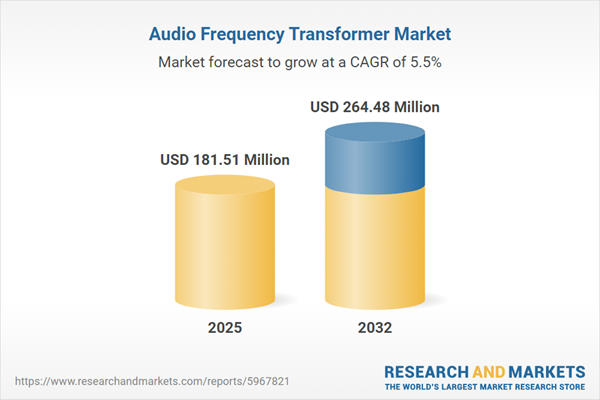Speak directly to the analyst to clarify any post sales queries you may have.
The audio frequency transformer market is advancing rapidly, shaped by evolving technological capabilities, regulatory frameworks, and changes in end-user requirements. Senior decision-makers require a clear view of this market’s trajectory to inform critical investments and operational choices.
Market Snapshot: Audio Frequency Transformer Market Size and Trends
The audio frequency transformer market grew from USD 172.18 million in 2024 to USD 181.51 million in 2025. The sector is projected to expand at a CAGR of 5.51%, aiming for USD 264.48 million by 2032. This growth reflects ongoing investments in signal processing, telecommunications, and high-fidelity sound systems, alongside increasing demand for robust transformers that ensure efficient energy management and signal integrity across industries.
Scope & Segmentation of the Audio Frequency Transformer Market
This report delivers comprehensive analysis by segmenting the market along core performance and organizational criteria:
- Phase Type: Single Phase, Three Phase
- Core Type: Laminated Core, Toroidal Core
- End User: Aerospace & Defense, Automotive, Consumer Electronics, Industrial, Renewable Energy & Power, Telecommunications
- Power Rating: High (over 1000 VA), Low (up to 250 VA), Medium (250–1000 VA)
- Winding Material: Aluminum, Copper
- Cooling Method: Dry Type, Oil Immersed
- Sales Channel: Aftermarket, OEM
- Regional Coverage: Americas (United States, Canada, Mexico, Brazil, Argentina, Chile, Colombia, Peru), Europe, Middle East & Africa (United Kingdom, Germany, France, Russia, Italy, Spain, Netherlands, Sweden, Poland, Switzerland, United Arab Emirates, Saudi Arabia, Qatar, Turkey, Israel, South Africa, Nigeria, Egypt, Kenya), Asia-Pacific (China, India, Japan, Australia, South Korea, Indonesia, Thailand, Malaysia, Singapore, Taiwan)
- Company Coverage: TDK Corporation, Murata Manufacturing Co., Ltd., Tamura Corporation, Triad Magnetics, Inc., Hammond Manufacturing Co. Limited, Lundahl Transformers AB, Sowter Transformers Ltd., Jensen Transformers, Inc., Cinemag, Inc., Edcor USA, Inc.
Key Takeaways for Decision-Makers
- New core materials—such as nanocrystalline and amorphous alloys—are enabling lower-loss designs and driving miniaturization and efficiency improvements.
- Digital simulation and modeling tools are reducing prototyping costs, shortening development cycles, and supporting advanced transformer customization for specialized industrial and commercial uses.
- Strategic supplier diversification is emerging as a response to global trade uncertainties, improving supply chain resilience and cost optimization across procurement and operations.
- Sustainability initiatives are accelerating the adoption of eco-friendly insulation and recyclable core structures, driven by both regulatory mandates and customer preference for sustainable power management solutions.
- OEM collaborations are strengthening with a focus on integrated solutions, predictive maintenance, and real-time diagnostics through sensor-enabled transformer systems.
- Regional policies—such as domestic manufacturing incentives in the Americas and stringent EMC standards in EMEA—are shaping both technology adoption and local investment strategies.
Tariff Impact: Navigating US Policy Shifts
The 2025 introduction of United States tariffs on critical raw materials, including steel, copper, and magnetic alloys, has influenced cost structures throughout the audio frequency transformer supply chain. Manufacturers have adapted by refining sourcing approaches and seeking partnerships with suppliers across Asia-Pacific and the Americas. Concurrently, engineering teams are optimizing product designs, material usage, and adopting alternative winding techniques to sustain margin targets and mitigate risks associated with tariff-driven price volatility. These dynamics reinforce the need for strategic planning around vertical integration and nearshoring.
Methodology & Data Sources
This analysis combines secondary data—such as industry reports, regulatory filings, technical standards, and white papers—with in-depth primary interviews involving design engineers, category managers, and sector-focused end users. Qualitative insights have been synthesized with quantitative metrics and validated through triangulation, ensuring accuracy and reliability throughout the segmentation and trend analysis.
Why This Report Matters
- Enables senior executives to benchmark operational strategies against global and regional market trends for audio frequency transformers and quickly identify actionable opportunities.
- Supports supply chain and product innovation leaders in adapting to dynamic policy regimes and new customer requirements, improving resilience and competitive positioning.
- Delivers robust segmentation analysis and evidence-based insights to underpin both near-term tactical decisions and long-range strategic planning.
Conclusion
The audio frequency transformer market is transitioning through a phase of innovation and transformation, shaped by regulatory, technological, and demand-side shifts. This report equips stakeholders with the knowledge required to navigate market volatility, develop sustainable solutions, and pursue growth opportunities with confidence.
Additional Product Information:
- Purchase of this report includes 1 year online access with quarterly updates.
- This report can be updated on request. Please contact our Customer Experience team using the Ask a Question widget on our website.
Table of Contents
3. Executive Summary
4. Market Overview
7. Cumulative Impact of Artificial Intelligence 2025
Companies Mentioned
The companies profiled in this Audio Frequency Transformer market report include:- TDK Corporation
- Murata Manufacturing Co., Ltd.
- Tamura Corporation
- Triad Magnetics, Inc.
- Hammond Manufacturing Co. Limited
- Lundahl Transformers AB
- Sowter Transformers Ltd.
- Jensen Transformers, Inc.
- Cinemag, Inc.
- Edcor USA, Inc.
Table Information
| Report Attribute | Details |
|---|---|
| No. of Pages | 186 |
| Published | October 2025 |
| Forecast Period | 2025 - 2032 |
| Estimated Market Value ( USD | $ 181.51 Million |
| Forecasted Market Value ( USD | $ 264.48 Million |
| Compound Annual Growth Rate | 5.5% |
| Regions Covered | Global |
| No. of Companies Mentioned | 11 |









